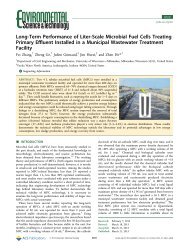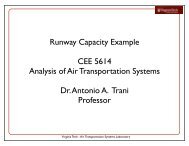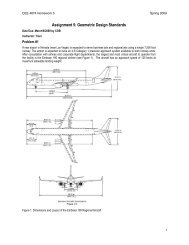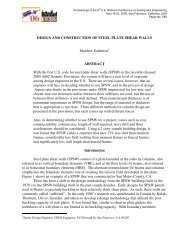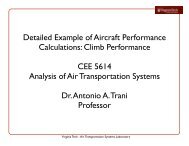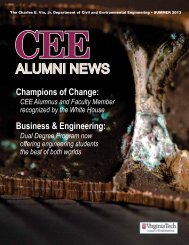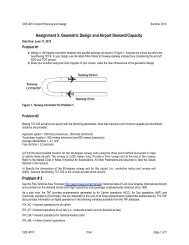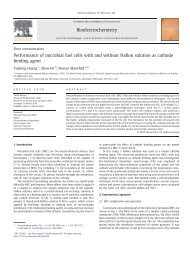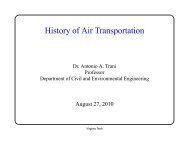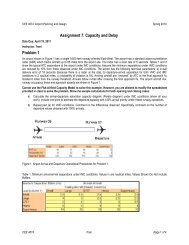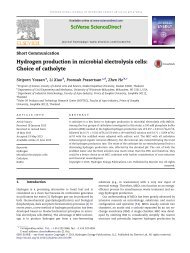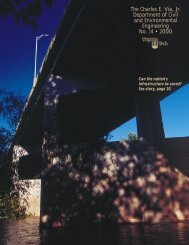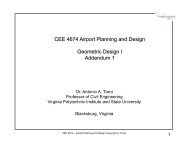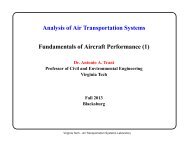Annual Report Year 2004 - Civil and Environmental Engineering
Annual Report Year 2004 - Civil and Environmental Engineering
Annual Report Year 2004 - Civil and Environmental Engineering
- No tags were found...
You also want an ePaper? Increase the reach of your titles
YUMPU automatically turns print PDFs into web optimized ePapers that Google loves.
as top mat in the spring of 2003. Live load tests were performedbefore the bridge was opened to traffic <strong>and</strong> identicaltests were repeated after the bridge had been in service oneyear. In addition, a companion slab was cast <strong>and</strong> placed in atest bed at the Troutville weigh station. This slab is subjectedto high traffic loadings <strong>and</strong> environmental conditioning. Afterone year the deck was removed <strong>and</strong> returned to the lab tobe tested. The tests of the weigh station deck were comparedto tests of an identical slab which had no loading or environmentalconditioning.Roberts-Wollmann has also directed projects investigatingfull-width, full-depth precast bridge deck panels, seismicdesign of Virginia bridges using new LRFD criteria, the developmentof optimum continuity diaphragm details for the newbulb-T girder being used in Virginia, anchorage zone behaviorin post-tensioned concrete, <strong>and</strong> ultra-high performanceconcrete. She continues to teach undergraduate <strong>and</strong> graduateclasses in reinforced <strong>and</strong> prestressed concrete, <strong>and</strong> remainsactive in professional committees of the American ConcreteInstitute <strong>and</strong> Prestressed/Precast Concrete Institute. She is anassociate editor for the ASCE Journal of Bridge <strong>Engineering</strong>.Avoiding annoying floor vibrationsThis year Tom Murray’s research focus has been on floorserviceability, steel connection design, metal building systems,<strong>and</strong> an innovative bridge deck system. The latter promisesto be a very attractive alternative to concrete deck/steelgirder systems. A demonstration bridge is expected to beconstructed in Virginia early in 2005.During the past year Murray presented seminars to engineeringgroups in Alabama, Colorado, <strong>and</strong> Maine on thedesign of floor systems to avoid annoying floor vibrations.Also, he continued his involvement with the AmericanInstitute of Steel Construction, American Iron <strong>and</strong> SteelInstitute, <strong>and</strong> Research Council on Structural Connectionsspecification committees.He earned the <strong>2004</strong> Alumni Teaching Excellence Awardfrom the CEE alumni board <strong>and</strong> the <strong>2004</strong> Distinguished<strong>Engineering</strong> Service Award from the University of KansasCollege <strong>Engineering</strong>.Results nix ECR for Virginia bridgesRichard Weyers completed his work on the corrosionprotection performance of epoxy coated reinforcing steel(ECR). It was demonstrated through the testing of 113 ECR<strong>and</strong> 30 black bar cores taken from bridge decks that 22 percentof the ECR will crack <strong>and</strong> spall the cover concrete inonly five additional years beyond black bar. Life cycle costanalysis considering initial construction, repair <strong>and</strong> rehabilitationcost demonstrated that ECR is not a cost-effective corrosionprotection solution in Virginia. Recommendations toVDOT were to use low permeable concrete, present clearcover depth specifications, <strong>and</strong> 316 LN stainless steel in allcritical structures in high deicer salt application areas such asNorthern Virginia <strong>and</strong> in high traffic zones. All other structuresare to be built with low permeable concrete <strong>and</strong> blackbar. The recommendation is under review by VDOT <strong>and</strong> theFederal Highway Administration (FHWA).Weyers teamed with Michael Brown <strong>and</strong> Steve Lane ofthe Virginia Transportation Research Council (VTRC) to estimatethe service life of bridge decks built in Virginia. Theseparate projects (Brown on deck cracking, Lane on concretepermeability, <strong>and</strong> Weyers on service life modeling) providedcost economies <strong>and</strong> effective use of organization personnel.During summer <strong>2004</strong>, 38 bridge decks were surveyed: 10 builtbetween 1968 <strong>and</strong> 1970 with black steel <strong>and</strong> 28 built with ECRbetween 1985 <strong>and</strong> 1991, of which 12 were built with low permeableconcrete <strong>and</strong> 16 with normal Portl<strong>and</strong> cement bridgedeck concrete. The survey crew consisted of Brown <strong>and</strong> AndyMills of VTRC <strong>and</strong> Weyers <strong>and</strong> graduate students Wes Keller<strong>and</strong> Andrei Ramniceanu. The survey decks had been identifiedby Weyers during his research leave in 2003 at VTRC. Thefield work included extensive linear cracking surveys, nondestructiveelectro-chemical corrosion measurements, <strong>and</strong> asbuiltconditions. In addition, 12 to 15 cores were taken fromeach bridge deck for laboratory analyses of concrete permeability,chloride contents, <strong>and</strong> corrosion state of the reinforcingsteel. The laboratory phase of the project is scheduledover an 18-month period with analyses to follow. Brown isconducting the laboratory work at VTRC.Weyers also started an aggregate durability project for theWisconsin Department of Transportation (WisDOT) duringthe year. The project is also a cooperative effort betweenVirginia Tech <strong>and</strong> VTRC. Aggregate laboratory testing beganthis summer, following aggregate sampling by graduate studentGreg Williamson <strong>and</strong> Weyers.Megan Wheeler <strong>and</strong> Wes Keller earned their master’sdegrees. Keller conducted the statistical analysis of the bridgedeck linear cracking data collected during the summer of2003, concluding that large spacing between girders results inmore longitudinal cracking <strong>and</strong> larger clear concrete coverdepths results in more linear cracking. Wheeler conductedscanning electron microscope crack analyses of ECR, degreeof epoxy coating cure, <strong>and</strong> moisture uptake analysis of ECRof both poor <strong>and</strong> good corrosion protection performance ofECR from the field core corrosion study. Results showed that60 percent of the coating on the bar is cracked with cracks atleast four magnitudes greater than the water <strong>and</strong> chloridemolecule, the coating water absorbed is about 1 percent inmoisture concrete, the coating on the bar is not fully cured,<strong>and</strong> the greater the amount of cracking <strong>and</strong> absorption ofwater, the greater state of not being fully cured. Both graduatesare working for consulting engineering firms.VDOT’s prestressed estimating method?Tommy Cousins continues to offer prestressed concrete<strong>and</strong> structural masonry design courses, <strong>and</strong> to investigatechallenges associated with bridge performance <strong>and</strong> longevity.His projects were all related to the development <strong>and</strong> use ofhigh performance materials in bridges. Through fundingreceived from the VTRC <strong>and</strong> the Virginia Cooperative Centerfor Bridge <strong>Engineering</strong> (which he serves as the director)Cousins, joined by Via Scholar Chris Waldron, is investigatingthe appropriateness of the method VDOT currently uses forestimating prestress loss in prestressed concrete bridge girders.This project involves the instrumentation <strong>and</strong> monitoringof prestressed girders in three bridges in the Commonwealth.During the summer of 2005, a historically significantthrough truss bridge in Covington, Va. will be rehabilitatedusing a lightweight FRP bridge deck system. This project isfunded by a grant from the FHWA <strong>and</strong> the VTRC. The throughtruss bridge currently has a reinforced concrete deck <strong>and</strong> alow posting. The lightweight FRP deck (which has one-thirdthe weight of the reinforced concrete deck) will allow theposting to be increased so that emergency vehicles can usethe bridge. The research is being conducted in collaborationwith Jack Lesko of engineering science <strong>and</strong> mechanics.27PROGRAM AREAS: SEM



